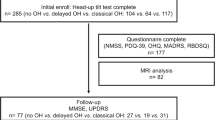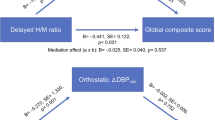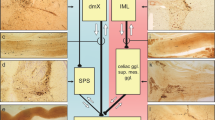Abstract
Differentiating between Parkinson disease (PD) and idiopathic normal pressure hydrocephalus (INPH) can be challenging for the practicing clinician. Patients with undiagnosed PD but with incidental ventriculomegaly run the risk of being subjected to unnecessary shunt surgery. Taking a family history of PD and establishing the presence of motor symptoms (tremor, rigidity, bradykinesia) and nonmotor symptoms could help to differentiate between the two disorders. For patients with parkinsonian features, a dopamine challenge test to exclude the possibility of idiopathic PD might be beneficial. In this article, we highlight the difficulty of accurately differentiating INPH from PD as illustrated by three clinical cases of patients referred for shunt surgery.
This is a preview of subscription content, access via your institution
Access options
Subscribe to this journal
Receive 12 print issues and online access
$209.00 per year
only $17.42 per issue
Buy this article
- Purchase on Springer Link
- Instant access to full article PDF
Prices may be subject to local taxes which are calculated during checkout



Similar content being viewed by others
References
Marmarou, A., Bergsneider, M., Relkin, N., Klinge, P. & Black, P. M. Development of guidelines for idiopathic normal-pressure hydrocephalus: introduction. Neurosurgery 57 (Suppl. 3), S1–S3 (2005).
Relkin, N., Marmarou, A., Klinge, P., Bergsneider, M. & Black, P. M. Diagnosing idiopathic normal-pressure hydrocephalus. Neurosurgery 57 (Suppl. 3), S4–S16 (2005).
Marmarou, A., Bergsneider, M., Klinge, P., Relkin, N. & Black, P. M. The value of supplemental prognostic tests for the preoperative assessment of idiopathic normal-pressure hydrocephalus. Neurosurgery 57 (Suppl. 3), S17–S28 (2005).
Bergsneider, M., Black, P. M., Klinge, P., Marmarou, A. & Relkin, N. Surgical management of idiopathic normal-pressure hydrocephalus. Neurosurgery 57 (Suppl. 3), S29–S39 (2005).
Klinge, P., Marmarou, A., Bergsneider, M., Relkin, N. & Black, P. M. Outcome of shunting in idiopathic normal-pressure hydrocephalus and the value of outcome assessment in shunted patients. Neurosurgery 57 (Suppl. 3), S40–S52 (2005).
Batra, S. & Rigamonti, D. Idiopathic normal pressure hydrocephalus: the benefits and problems of shunting. Nat. Clin. Pract. Neurol. 5, 80–81 (2009).
Pujari, S. et al. Normal pressure hydrocephalus: long-term outcome after shunt surgery. J. Neurol. Neurosurg. Psychiatry 79, 1282–1286 (2008).
Gallia, G. L., Rigamonti, D. & Williams, M. A. The diagnosis and treatment of idiopathic normal pressure hydrocephalus. Nat. Clin. Pract. Neurol. 2, 375–381 (2006).
Sahuquillo, J. et al. Reappraisal of the intracranial pressure and cerebrospinal fluid dynamics in patients with the so-called “normal pressure hydrocephalus” syndrome. Acta Neurochir. (Wien) 112, 50–61 (1991).
Krauss, J. K. et al. Movement disorders in adult hydrocephalus. Mov. Disord. 12, 53–60 (1997).
Stolze, H. et al. Comparative analysis of the gait disorder of normal pressure hydrocephalus and Parkinson's disease. J. Neurol. Neurosurg. Psychiatry 70, 289–297 (2001).
Stamey, W., Davidson, A. & Jankovic, J. Shoulder pain: a presenting symptom of Parkinson disease. J. Clin. Rheumatol. 14, 253–254 (2008).
Chaudhuri, K. R. & Naidu, Y. Early Parkinson's disease and non-motor issues. J. Neurol. 255 (Suppl. 5), 33–38 (2008).
Chaudhuri, K. R. et al. International multicenter pilot study of the first comprehensive self-completed nonmotor symptoms questionnaire for Parkinson's disease: the NMSQuest study. Mov. Disord. 21, 916–923 (2006).
Takeuchi, T. et al. Pathophysiology of cerebral circulatory disorders in idiopathic normal pressure hydrocephalus. Neurol. Med. Chir. (Tokyo) 47, 299–306 (2007).
Kitagaki, H. et al. CSF spaces in idiopathic normal pressure hydrocephalus: morphology and volumetry. AJNR Am. J. Neuroradiol. 19, 1277–1284 (1998).
Krauss, J. K. et al. White matter lesions in patients with idiopathic normal pressure hydrocephalus and in an age-matched control group: a comparative study. Neurosurgery 40, 491–495 (1997).
Akiguchi, I. et al. Shunt-responsive parkinsonism and reversible white matter lesions in patients with idiopathic NPH. J. Neurol. 255, 1392–1399 (2008).
Racette, B. A. et al. Pathophysiology of parkinsonism due to hydrocephalus. J. Neurol. Neurosurg. Psychiatry 75, 1617–1619 (2004).
Ouchi, Y. et al. In vivo presynaptic and postsynaptic striatal dopamine functions in idiopathic normal pressure hydrocephalus. J. Cereb. Blood Flow Metab. 27, 803–810 (2007).
Kim, M. J., Chung, S. J., Sung, Y. H., Lee, M. C. & Im, J. H. Levodopa-responsive parkinsonism associated with hydrocephalus. Mov. Disord. 21, 1279–1281 (2006).
Curran, T. & Lang, A. E. Parkinsonian syndromes associated with hydrocephalus: case reports, a review of the literature, and pathophysiological hypotheses. Mov. Disord. 9, 508–520 (1994).
Esteguy, M., Bonnet, A. M., Kefalos, J., Lhermitte, F. & Agid, Y. The L-dopa test in Parkinson's disease. Rev. Neurol. (Paris) 141, 413–415 (1985).
Hughes, A. J., Lees, A. J. & Stern, G. M. Challenge tests to predict the dopaminergic response in untreated Parkinson's disease. Neurology 41, 1723–1725 (1991).
Merello, M., Nouzeilles, M. I., Arce, G. P. & Leiguarda, R. Accuracy of acute levodopa challenge for clinical prediction of sustained long-term levodopa response as a major criterion for idiopathic Parkinson's disease diagnosis. Mov. Disord. 17, 795–798 (2002).
Albanese, A. et al. Consensus statement on the role of acute dopaminergic challenge in Parkinson's disease. Mov. Disord. 16, 197–201 (2001).
Acknowledgements
This work was supported by a grant from The National Parkinson Foundation Center of Excellence at the University of Florida.
Author information
Authors and Affiliations
Corresponding author
Ethics declarations
Competing interests
The authors declare no competing financial interests.
Rights and permissions
About this article
Cite this article
Morishita, T., Foote, K. & Okun, M. INPH and Parkinson disease: differentiation by levodopa response. Nat Rev Neurol 6, 52–56 (2010). https://doi.org/10.1038/nrneurol.2009.195
Issue Date:
DOI: https://doi.org/10.1038/nrneurol.2009.195
This article is cited by
-
Parkinsonism in idiopathic normal pressure hydrocephalus: is it time for defining a clinical tetrad?
Neurological Sciences (2022)
-
The investigation of the gait parameter alterations in response to levodopa therapy and tap test in patients with idiopathic normal pressure hydrocephalus
Neurological Sciences (2022)
-
Diffusion tensor imaging in elderly patients with idiopathic normal pressure hydrocephalus or Parkinson’s disease: diagnosis of gait abnormalities
Fluids and Barriers of the CNS (2012)



